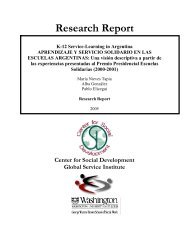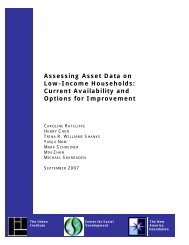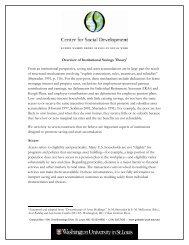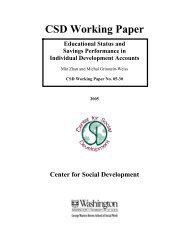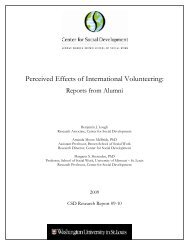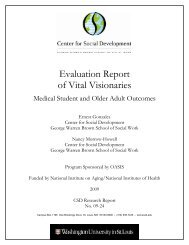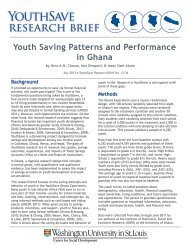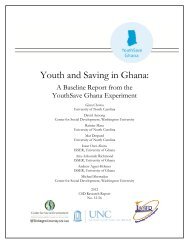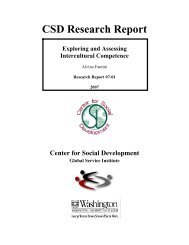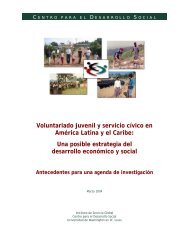Rediscovering social investment in developmental welfare state ...
Rediscovering social investment in developmental welfare state ...
Rediscovering social investment in developmental welfare state ...
Create successful ePaper yourself
Turn your PDF publications into a flip-book with our unique Google optimized e-Paper software.
R E D I S C O V E R I N G S O C I A L I N V E S T M E N T I N D E V E L O P M E N T A L W E L F A R E S T A T E P O L I C I E S :<br />
B A C K T O T H E F U T U R E<br />
<strong>in</strong>terest was focused on predictors of <strong>welfare</strong> <strong>state</strong> development. Over time, with the diffusion and<br />
elaboration of <strong>welfare</strong> <strong>state</strong> programs, understand<strong>in</strong>g of the <strong>welfare</strong> <strong>state</strong> became more nuanced and<br />
ref<strong>in</strong>ed, reflected <strong>in</strong> part <strong>in</strong> the movement toward typologies. Similarly, as the <strong>welfare</strong> <strong>state</strong> came to<br />
be seen as hav<strong>in</strong>g varied forms, this raised scholarly <strong>in</strong>terest <strong>in</strong> the types of policies (or regimes)<br />
most successful <strong>in</strong> reduc<strong>in</strong>g poverty. While there has been gradual progress <strong>in</strong> del<strong>in</strong>eat<strong>in</strong>g or<br />
disaggregat<strong>in</strong>g aspects of <strong>welfare</strong> <strong>state</strong> effort and effects, the gap between what we know about its<br />
harmful versus beneficial aspects has not substantially narrowed. Current socioeconomic<br />
circumstances have led to fresh questions about whether different types of <strong>welfare</strong> <strong>state</strong> policies can<br />
have positive effects with m<strong>in</strong>imal costs. I argue that a potential fourth generation of research should<br />
be denoted by explicitly analyz<strong>in</strong>g productive outcomes alongside distributive ones. As such, I would<br />
suggest that a fourth generation has not yet coalesced. There is no coherent theoretical framework<br />
for reth<strong>in</strong>k<strong>in</strong>g <strong>welfare</strong> <strong>state</strong> effort <strong>in</strong> terms of its impact on outcomes beyond but associated with<br />
<strong>in</strong>come poverty and <strong>in</strong>equality. In other words, there is no theoretical framework, beyond those that<br />
have guided <strong>welfare</strong> <strong>state</strong> research for decades, which <strong>in</strong>forms th<strong>in</strong>k<strong>in</strong>g about the implications of<br />
poverty for economic development, systematically consider<strong>in</strong>g <strong>social</strong> protection as a productive<br />
factor, and explor<strong>in</strong>g the possible economically beneficial impact of <strong>welfare</strong> <strong>state</strong> effort. 10<br />
While each generation of research is exam<strong>in</strong>ed <strong>in</strong> greater detail <strong>in</strong> Johnson (2010), we can clearly<br />
discern and briefly <strong>state</strong> some central research f<strong>in</strong>d<strong>in</strong>gs. What do we know? In the broadest terms we<br />
know that <strong>social</strong> policy appears to have a positive effect on reduc<strong>in</strong>g poverty above and beyond<br />
macroeconomic conditions. There are wide crosscountry differences <strong>in</strong> the level and mixture of<br />
public and private expenditure. Similarly, there rema<strong>in</strong>s a diversity of outcomes across countries <strong>in</strong><br />
terms of both poverty rates and economic performance. Select crossnational research f<strong>in</strong>d<strong>in</strong>gs show<br />
substantial differences <strong>in</strong> levels of market poverty and also show, despite relatively similar levels <strong>in</strong><br />
<strong>welfare</strong> <strong>state</strong> spend<strong>in</strong>g, posttax/transfer poverty rates vary considerably; as noted above, only mixed<br />
evidence supports the notion of a uniform efficiency-equality tradeoff. It appears that what happens<br />
with<strong>in</strong> <strong>social</strong> expenditure matters as much for reduc<strong>in</strong>g poverty and <strong>in</strong>equality as overall government<br />
spend<strong>in</strong>g. However, we do not know much about which policy comb<strong>in</strong>ations or clusters are<br />
particularly beneficial <strong>in</strong> avoid<strong>in</strong>g poverty with m<strong>in</strong>imal economic costs, and whether this is true<br />
across countries and their varied <strong>in</strong>stitutional contexts. Recogniz<strong>in</strong>g the l<strong>in</strong>k between variations<br />
with<strong>in</strong> expenditure and diversity <strong>in</strong> economic and <strong>social</strong> performance across countries can aid<br />
understand<strong>in</strong>g of whether and how the <strong>welfare</strong> <strong>state</strong> contributes to economic performance.<br />
While we are beg<strong>in</strong>n<strong>in</strong>g to understand the variety of potential effects of the <strong>welfare</strong> <strong>state</strong>, and to see<br />
some connections between <strong>welfare</strong> <strong>state</strong> effort and the varied effects, what is miss<strong>in</strong>g is a conceptual<br />
framework for th<strong>in</strong>k<strong>in</strong>g systematically about how <strong>welfare</strong> <strong>state</strong> effort and effects are related. We<br />
need to clarify which types of efforts should have which effects. Arguably, what is most problematic<br />
about exist<strong>in</strong>g approaches to th<strong>in</strong>k<strong>in</strong>g about the <strong>welfare</strong> <strong>state</strong> and what it produces, and hence why<br />
there is a need for a new perspective, can be summarized <strong>in</strong> terms of three metatheoretical concerns:<br />
1) limitations of ways that <strong>welfare</strong> <strong>state</strong> effort has been measured; 2) limitations <strong>in</strong> the <strong>welfare</strong> <strong>state</strong><br />
outcomes that have been exam<strong>in</strong>ed, e.g., narrowness of outcomes and weak measurement; and 3)<br />
the consequences of th<strong>in</strong>k<strong>in</strong>g about <strong>welfare</strong> <strong>state</strong> arrangements and outcomes separately.<br />
10 Research rema<strong>in</strong>s conf<strong>in</strong>ed to distributional outcomes and does not explicitly deal with the productive implications of<br />
distribution or how the possibility of <strong>social</strong> protection as a productive factor might lead to more theoretically coherent<br />
or predictive th<strong>in</strong>k<strong>in</strong>g about a disparate array of measures of <strong>welfare</strong> <strong>state</strong> effort.<br />
C E N T E R F O R S O C I A L D E V E L O P M E N T<br />
W A S H I N G T O N U N I V E R S I T Y I N S T . L O U I S<br />
8



